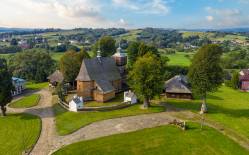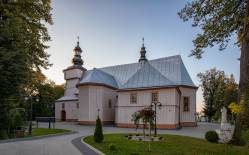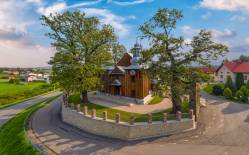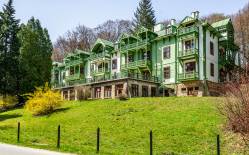In administrative terms the village of Rymanów-Zdrój was only established in 1996. It was created in areas of the villages of Posada Górna, Deszno and Wołtuszowa. The mineral springs were discovered here in 1876. These are three springs of healing water, known as Klaudia, Tytus and Celestyna. The spa resort was started here in 1881 by the Potocki family, owners of the estate. The first villas and facilities for guests were launched along with the central spa house.
In 1905 there were thirty-eight private guesthouses and two facilities for orthopaedic exercise. In the summer of 1912, the western part of the spa resort burned down. The new spa bath house was only built in 1926. Baths in therapeutic mud were introduced in 1932. In the final years of the interwar period approximately 5,000 guests visited the spa resort annually. During WWII the so-called Kurhaus, the most elegant spa facility, was destroyed by fire. After the war Rymanów-Zdrój was Poland’s second largest spa resort for children, preceded only by Kołobrzeg at the seaside.
The central part of the spa resort today, the Spa Park comprises a wooden Pump Room, similar in its shape to the old Springs Pavilion, as well as a few historical wooden villas. Those particularly interesting are the villas named: Pod Matką Boską (today: Maria), Opatrzność, Gołąbek, Biały Orzeł, Pogoń and Leliwa.
Most of these are log houses, usually comprising two floors and double-span interior layout. The outer walls are clad with horizontal wood boards. Many of these buildings comprise such structures as avant-corps, balconies, verandas and porches. The architecture was inspired by similar facilities existing in Tyrol and Switzerland, where the fashion related to Sanus Per Aquam (SPA) started and spread across the Habsburg Empire.
The spa resort of Rymanów-Zdrój provides preventive therapies, as well as treatments and rehabilitation for patients with respiratory diseases, such as bronchial asthma, recurring rhinosinusitis, pharyngitis, tonsillitis and bronchitis, pneumonia, or conditions following lung resection, as well as cardiovascular diseases (early cardiac rehabilitation), hypertension and atherosclerosis. Additionally, the spa resort provides treatments for children with kidney and urologic diseases.
Photo: Michał Bosek (UMWP)
Gallery
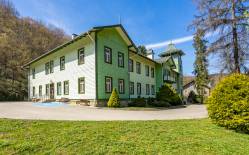
Recommended venues on the Trail



This website has been modernized with the financial support of the European Union under the Cross-Border Cooperation Programme Poland-Belarus-Ukraine 2014-2020. The responsibility for its content lies solely with the Podkarpackie Regional Tourism Board and cannot, in any case, be treated as a reflection of the position of the European Union, the Managing Authority, or the Joint Technical Secretariat of the Cross-Border Cooperation Programme Poland-Belarus-Ukraine 2014-2020.










